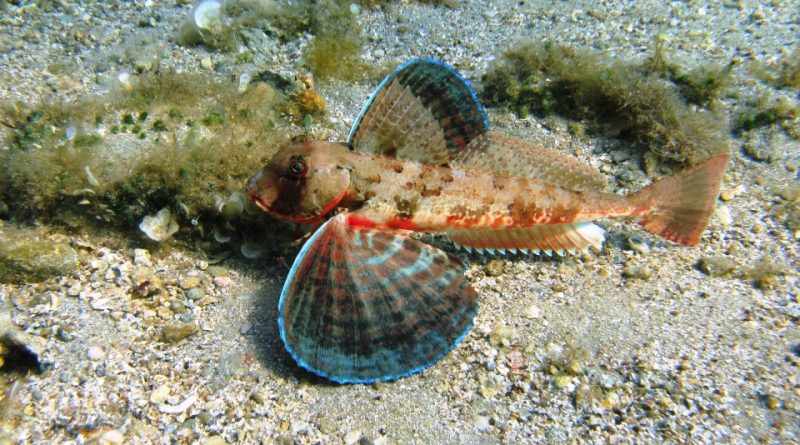Chelidonichthys lastoviza
Chelidonichthys lastoviza
The streaked gurnard or African gurnard, rock gurnard (Chelidonichthys lastoviza Bonnaterre, 1788) is a sea fish belonging to the Triglidae family.
Systematic –
From a systematic point of view it belongs to:
Eukaryota domain,
Kingdom Animalia,
Subkingdom Eumetazoa,
Phylum Chordata,
Subphylum Vertebrata,
Superclass Gnathostomata,
Class Actinopterygii,
Infraclass Teleostei,
Order Scorpaeniformes,
Suborder Scorpaenoidea,
Triglidae family,
Genus Chelidonichthys,
Species C. lastoviza.
The term is basionym:
– Trigla lastoviza Bonnaterre, 1788.
The terms are synonymous:
– Chelidonichthys africana (Smith, 1934);
– Cuculus lineatus Pennant, 1769;
– Trigla adriatica Gmelin, 1789;
– Trigla africana Smith, 1934;
– Trigla gonotus Rafinesque, 1810;
– Trigla lastoviza Bonnaterre, 1788;
– Trigla lineata Gmelin, 1789;
– Trigloporus africanus (Smith, 1934);
– Trigloporus lastovitza (Bonnaterre, 1788);
– Trigloporus lastoviza (Bonnaterre, 1788);
– Trigloporus lastoviza subsp. africanus (Smith, 1934);
– Trigloporus lineata (Gmelin, 1789);
– Trygloporus lastoviza (Bonnaterre, 1788).
Two subspecies are recognized within this species:
– Chelidonichthys lastoviza lastoviza (Bonnaterre, 1788); present in the eastern Atlantic south of Angola;
– Chelidonichthys lastoviza africana (J. L. B. Smith, 1934); present in southern Africa.
Geographic Distribution and Habitat –
Chelidonichthys lastoviza is a fish that lives in the eastern Atlantic Ocean and western Indian Ocean.
Specifically, it is found in the eastern Atlantic Ocean, from southern Norway and Scotland to the Cape of Good Hope and along the coast of South Africa in the southwestern Indian Ocean to Mozambique. It is also found around the Macaronesia Islands and the islands of the Gulf of Guinea. It is found in the Mediterranean Sea but is absent in the Black Sea. In Italian seas it seems more common in the Adriatic.
Its habitat is that of the seabed with rocky and sandy substrates and sand, in shallow coastal waters up to deep waters up to 150 m.
Description –
Chelidonichthys lastoviza is a fish with a slender body, almost circular in section, which tapers from the head towards the caudal peduncle. Normally it does not exceed 25 cm (exceptionally up to 40).
It has a carmine red color on the upper part of the body, tail and head which quickly fades to white on the sides and belly. The dorsal parts are reddish with irregular oblique spots.
The anal is red at the base and yellowish white at the outer edge. The pectorals are purplish, with whitish rays and cobalt-blue spots in the interradial spaces, more evident on the lower surface; the upper surface is brick red with dark spots; free rays are red with dark transverse stripes. The iris is white with bluish reflections.
The body, except the ventral area, is covered by scales half hidden by the skin. The lateral line, starting from the operculum, follows the dorsal profile and on it there are 62-67 scales equipped with small spines.
The head is armored with the presence of bony plates and the profile of the snout is steep and slightly sunken. The eye is relatively small and located high. The upper margin of the orbit is equipped with 3 spines. The front nostril is a small hole and the back is a slit.
The mouth is horizontal and not very large. The teeth are villiform and are located on the maxillae and on the vomer.
The two dorsal fins are housed in a longitudinal groove and along its edges there is a series of 25 shields, pointed in juveniles and blunt and grainy in adults. The first fin has a triangular shape, with 9-11 spiny rays, which from the second to the sixth are long, while the subsequent ones have a rapid degradation in height. The second ridge is extended and originates after a very short space from the first; it has 16-17 soft rays of almost constant height. The anal (15-16 soft rays) is opposite and almost equal to the second dorsal. The caudal has 12 rays and is spatulate with a slightly hollowed posterior margin in the centre. The pectorals (13 rays) are broad and the last 3 rays are free, elongated and articulated. The ventral ones have 1 spiny ray and 5 soft ones, they are wide, but shorter than the pectoral ones.
Biology –
Chelidonichthys lastoviza is a benthic fish that frequents mud and sand bottoms (never deeper than 100 m). It is frequently found around 20 m.
Reproduction occurs in summer and the eggs are small and pelagic. In the European population, egg laying occurs in midsummer, from June to August.
Ecological Role –
Chelidonichthys lastoviza was first formally described as Trigla lastoviza in 1788 by the French naturalist Pierre Joseph Bonnaterre with the type locality given as Split, Croatia. In 1934 J. L. B. Smith described a new subgenus of the genus Trigla called Trigloporus for his newly described species Trigla Africana. Some authorities have treated it as a valid genus, but it is currently classified as a subgenus of Chelidonichthys.
These fish can form schools when close to the surface. Their diet is mainly composed of small benthic brachyur crustaceans.
It is caught by trawling and trammel nets in sandy and muddy areas; occasionally takes the bait.
It is often caught with trawl nets, but only the largest specimens are kept. It appears regularly in the fish markets of the western Mediterranean, the Adriatic and Cyprus, rarely elsewhere. The catch is marketed fresh or chilled.
Guido Bissanti
Sources
– Wikipedia, the free encyclopedia.
– GBIF, the Global Biodiversity Information Facility.
– Louisy P., 2016. Guide to the identification of marine fishes of Europe and the Mediterranean. Il Castello Editore, Milan.
– Nikiforos G., 2008. Fauna of the Mediterranean. Giunti Editore, Florence.
Photo source:
– https://inaturalist-open-data.s3.amazonaws.com/photos/276563976/original.jpeg


